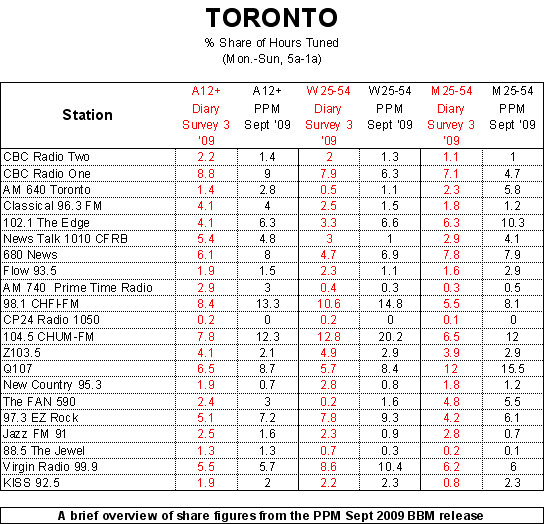BBM 2009:s3 Versus PPM Overview
 With the release of today’s PPM numbers covering 4 weeks in September we have begun continuous measurement, with PPM ultimately replacing diary numbers as the trading currency for programmers and advertisers. Which method best represents the truth? Well, truth is relative. The fact is both systems offer estimates with a certain margin of error.
With the release of today’s PPM numbers covering 4 weeks in September we have begun continuous measurement, with PPM ultimately replacing diary numbers as the trading currency for programmers and advertisers. Which method best represents the truth? Well, truth is relative. The fact is both systems offer estimates with a certain margin of error.
Here are some of the preliminary differences evident in the two sets of figures. Diary generally reports that people listen to three stations. PPM says six to seven stations. Certain types of stations seem to suffer with PPM. Heritage stations experience a bit of halo tuning in diary reporting (which relies on the listener’s memory) which disappears with the passive recording of PPM. CBC Radio One or Two, which get a bit of what I’ll call “aspirational reporting” in the diary lose that benefit with PPM, specifically in the core 25-54 demographic. Conversely “office” stations thrive under the passive reporting format. Younger rock stations, which had trouble getting young adult males to fill out diaries, seem to come back strong with PPM.
Now let’s take a look what the latest PPM figures released today tell us in comparison to the last book.
Toronto: Bragging rights at the top of the ratings heap go to CHFI-FM with a 13.3% share of hours tuned for A12+ (up from 8.4% in the summer diary) followed by CHUM-FM with a 12.3% (up from 7.8%). CHUM-FM leads the way for females 25-54 with a 20.2% share (up from 12.8% in the summer diary) followed by CHFI-FM with 14.8% share (up from 10.6%). Q107 is on top for males 25-54, posting a 15.5% share (up from 8.4% in the diary). The Edge held their lead with M18-34 turning in a 20.1% share (up from 14.4% in the diary).
See summary chart belowA brief overview of share figures from the PPM Sept 2009 BBM release courtesy of David Bray...

